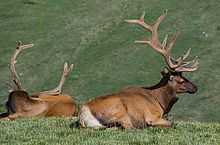Rocky Mountain elk
| Rocky Mountain elk | |
|---|---|
 | |
| Scientific classification | |
| Kingdom: | Animalia |
| Phylum: | Chordata |
| Class: | Mammalia |
| Order: | Artiodactyla |
| Suborder: | Ruminantia |
| Family: | Cervidae |
| Subfamily: | Cervinae |
| Genus: | Cervus |
| Species: | C. canadensis |
| Subspecies: | C. c. nelsoni |
| Binomial name | |
| Cervus canadensis (Erxleben, 1777)[1] | |
| Trinomial name | |
| Cervus canadensis nelsoni | |
The Rocky Mountain elk (Cervus canadensis nelsoni) is a subspecies of elk found in the Rocky Mountains and adjacent ranges of Western North America. The winter ranges are most common in open forests and floodplain marshes in the lower elevations. In the summer it migrates to the subalpine forests and alpine basins. The total wild population is about one million individuals.
The Rocky Mountain elk was re-introduced in 1913 to Colorado from Wyoming after the near extinction of the regional herds. While overhunting is a significant contributing factor, the elk’s near extinction is mainly attributed to human encroachment and destruction of their natural habitats and migratory corridors.
As of 2010, the Rocky Mountain elk herd has been diagnosed with a serious disorder called Chronic Wasting Disease (CWD). CWD affects the brain tissue of infected elk and is similar in symptoms to bovine spongiform encephalopathy (BSE), commonly known as mad-cow disease (MCD). There is no evidence to conclude that elk CWD is transmittable to humans, and research concerning CWD and its effect on the eco-system continues. Environmental and CWD problems in Estes Park, Colorado and, on a greater scale, throughout the Western U.S. and North America have local, state, and federal policy makers searching for solutions.
The Rocky Mountain National Park and the Estes Park environments are physically disrupted by the migration of the elk, ranging in size from calves to full-grown 700-pound adults. Several indigenous butterfly and plant species are harmed, especially the aspen groves that the elk herd of perhaps 3,000 animals decimates in its search for food. The elk population, while taxing the common food resources, also adversely affects native species that share the same food supply, such as the indigenous beavers.
References
- ↑ Erxleben, J.C.P. (1777) Anfangsgründe der Naturlehre and Systema regni animalis.
- Plan for Sharpshooters to Thin Colorado Elk Herd Draws Critics. By KIRK JOHNSON. Published: May 28, 2006 http://www.nytimes.com/2006/05/28/us/28elk.html
- Fibrils in brain of Rocky Mountain elk with chronic wasting disease contain scrapie amyloid. Guiroy DC, Williams ES, Song KJ, Yanagihara R, Gajdusek DC. Laboratory of Central Nervous System Studies, National Institute of Neurological Disorders and Stroke, National Institutes of Health, Bethesda, MD 20892.
- http://www.ncbi.nlm.nih.gov/pubmed/8372644
- Neurobiology of Disease, Chronic Wasting Disease of Elk: Transmissibility to Humans Examined by Transgenic Mouse Models. Qingzhong Kong,1 Shenghai Huang,1 Wenquan Zou,1 Difernando Vanegas,1 Meiling Wang,1 Di Wu,1 Jue Yuan,1 Mengjie Zheng,1 Hua Bai,1 Huayun Deng,2 Ken Chen,3 Allen L. Jenny,4 Katherine O'Rourke,5 Ermias D. Belay,6 Lawrence B. Schonberger,6 Robert B. Petersen,1 Man-Sun Sy,1 Shu G. Chen,1 and Pierluigi Gambetti1. http://www.jneurosci.org/cgi/content/abstract/25/35/7944
- Chronic Wasting Disease Alliance
- Rocky Mountain Elk Foundation
- The Safety of Elk Meat - http://www.elk-hunting.org/elk-meat#the-safety-of-elk-meat